Business Process Management Report: As-Is, To-Be, and Automation
VerifiedAdded on 2021/05/27
|21
|3563
|24
Report
AI Summary
This report delves into the realm of Business Process Management (BPM), focusing on the development of conceptual models for business processes. The report utilizes Business Process Model Notation (BPMN) to visually represent the current (As-Is) and proposed (To-Be) business processes within an organization. The study begins with an introduction to BPM, followed by the creation of Level 1 and Level 2 As-Is diagrams, illustrating the current state of processes. The report then constructs a To-Be model, outlining the desired future state. Key problems within the existing processes are identified, and solutions are proposed, incorporating best practices such as Activity Automation, Outsourcing, Integration, and Activity Elimination. Recommendations include stakeholder interviews, current state assessments, and the development of implementation roadmaps. The report emphasizes the importance of business agility, cost reduction, and revenue enhancement through effective BPM. A detailed discussion on the role of automation as a future solution is provided, along with justifications and an examination of its advantages and disadvantages. The report concludes with a discussion of logical automated business processing.
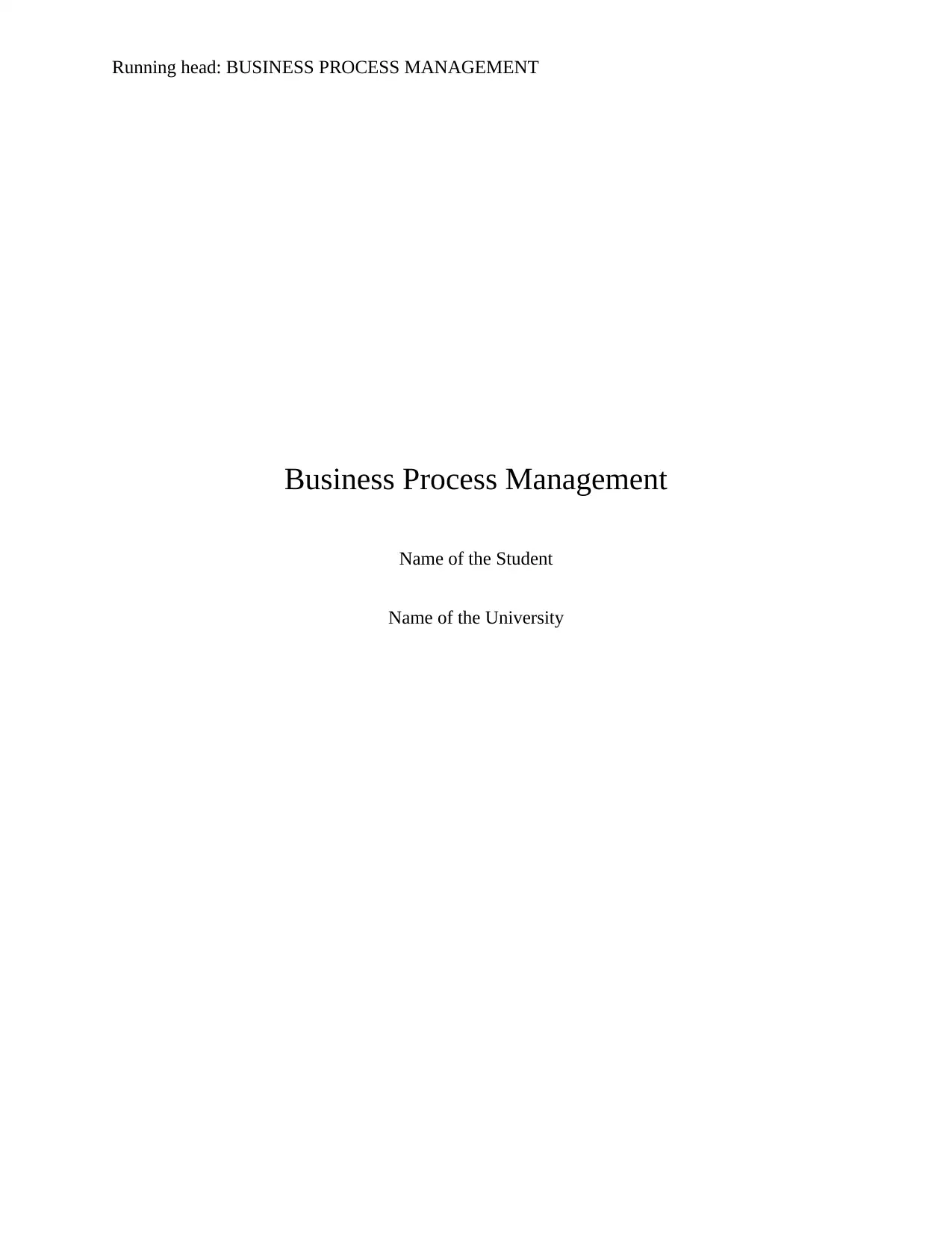
Running head: BUSINESS PROCESS MANAGEMENT
Business Process Management
Name of the Student
Name of the University
Business Process Management
Name of the Student
Name of the University
Paraphrase This Document
Need a fresh take? Get an instant paraphrase of this document with our AI Paraphraser
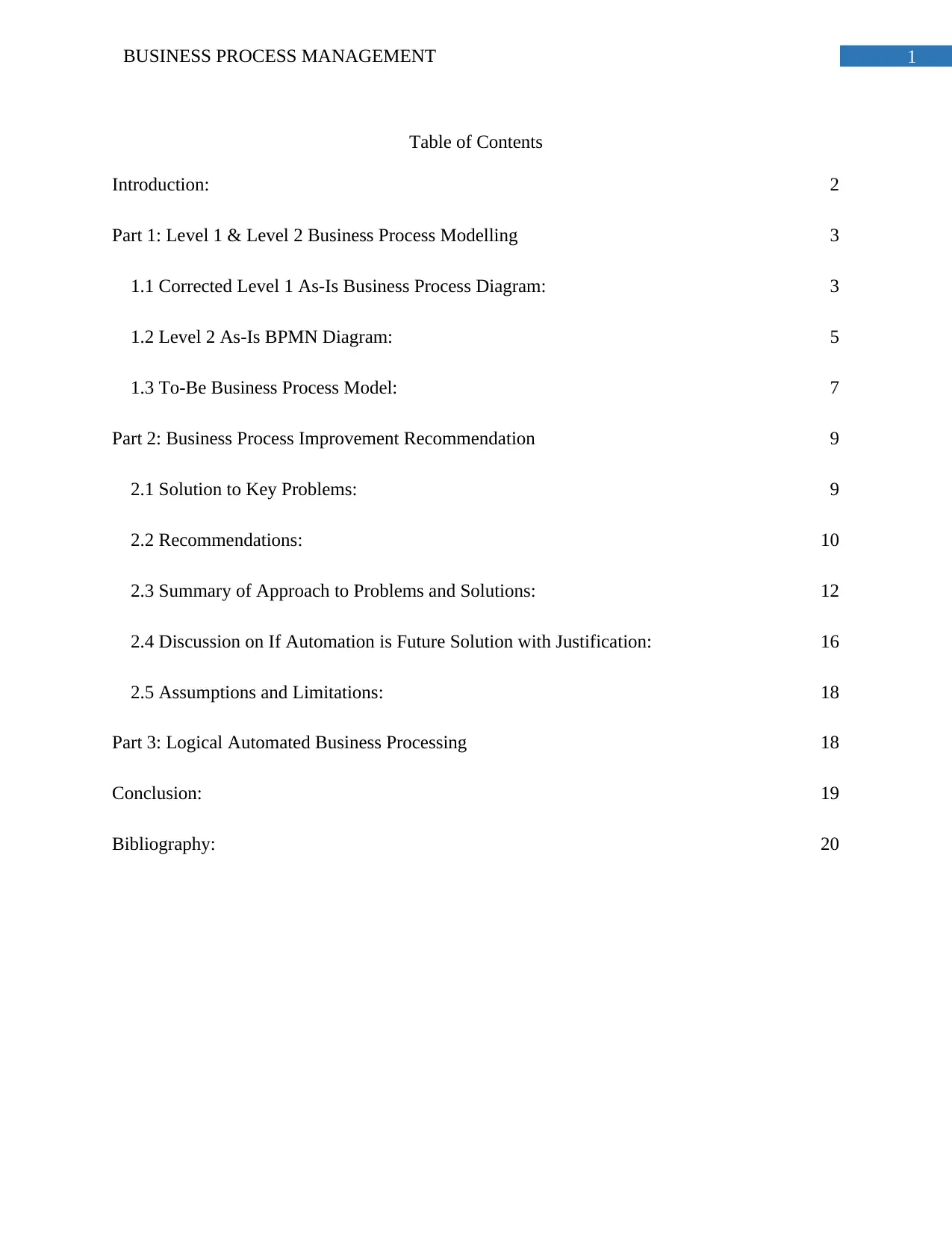
1BUSINESS PROCESS MANAGEMENT
Table of Contents
Introduction: 2
Part 1: Level 1 & Level 2 Business Process Modelling 3
1.1 Corrected Level 1 As-Is Business Process Diagram: 3
1.2 Level 2 As-Is BPMN Diagram: 5
1.3 To-Be Business Process Model: 7
Part 2: Business Process Improvement Recommendation 9
2.1 Solution to Key Problems: 9
2.2 Recommendations: 10
2.3 Summary of Approach to Problems and Solutions: 12
2.4 Discussion on If Automation is Future Solution with Justification: 16
2.5 Assumptions and Limitations: 18
Part 3: Logical Automated Business Processing 18
Conclusion: 19
Bibliography: 20
Table of Contents
Introduction: 2
Part 1: Level 1 & Level 2 Business Process Modelling 3
1.1 Corrected Level 1 As-Is Business Process Diagram: 3
1.2 Level 2 As-Is BPMN Diagram: 5
1.3 To-Be Business Process Model: 7
Part 2: Business Process Improvement Recommendation 9
2.1 Solution to Key Problems: 9
2.2 Recommendations: 10
2.3 Summary of Approach to Problems and Solutions: 12
2.4 Discussion on If Automation is Future Solution with Justification: 16
2.5 Assumptions and Limitations: 18
Part 3: Logical Automated Business Processing 18
Conclusion: 19
Bibliography: 20
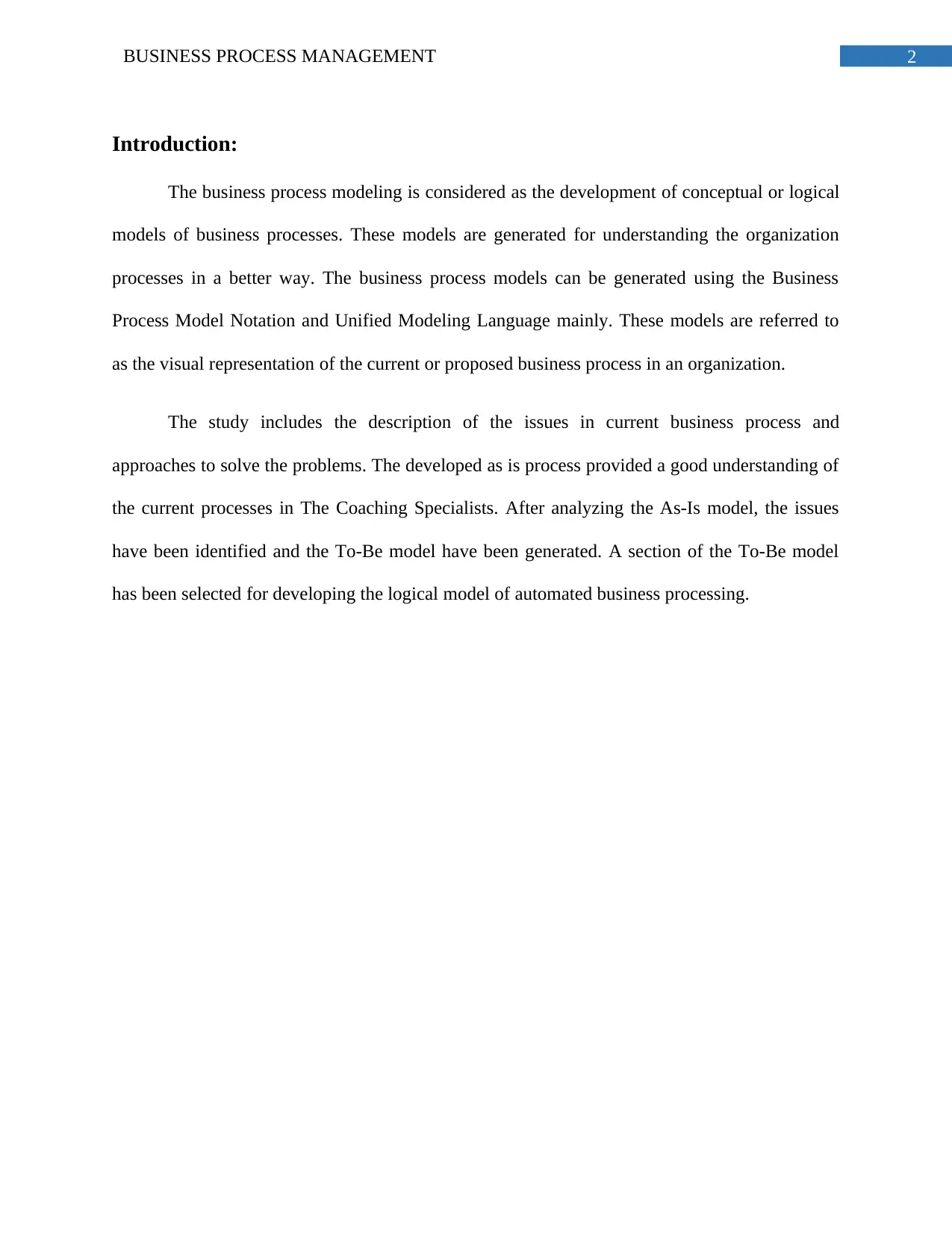
2BUSINESS PROCESS MANAGEMENT
Introduction:
The business process modeling is considered as the development of conceptual or logical
models of business processes. These models are generated for understanding the organization
processes in a better way. The business process models can be generated using the Business
Process Model Notation and Unified Modeling Language mainly. These models are referred to
as the visual representation of the current or proposed business process in an organization.
The study includes the description of the issues in current business process and
approaches to solve the problems. The developed as is process provided a good understanding of
the current processes in The Coaching Specialists. After analyzing the As-Is model, the issues
have been identified and the To-Be model have been generated. A section of the To-Be model
has been selected for developing the logical model of automated business processing.
Introduction:
The business process modeling is considered as the development of conceptual or logical
models of business processes. These models are generated for understanding the organization
processes in a better way. The business process models can be generated using the Business
Process Model Notation and Unified Modeling Language mainly. These models are referred to
as the visual representation of the current or proposed business process in an organization.
The study includes the description of the issues in current business process and
approaches to solve the problems. The developed as is process provided a good understanding of
the current processes in The Coaching Specialists. After analyzing the As-Is model, the issues
have been identified and the To-Be model have been generated. A section of the To-Be model
has been selected for developing the logical model of automated business processing.
⊘ This is a preview!⊘
Do you want full access?
Subscribe today to unlock all pages.

Trusted by 1+ million students worldwide
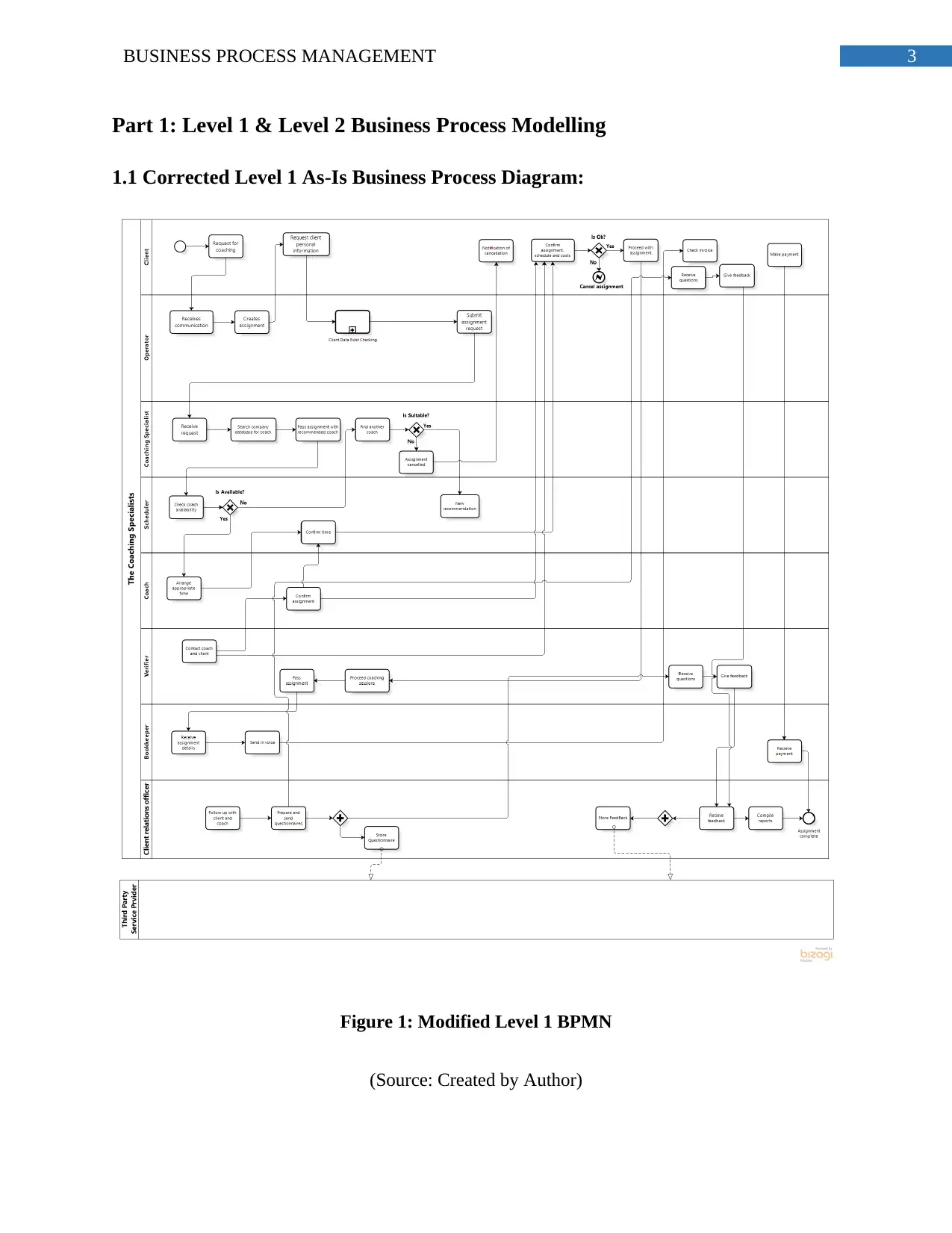
3BUSINESS PROCESS MANAGEMENT
Part 1: Level 1 & Level 2 Business Process Modelling
1.1 Corrected Level 1 As-Is Business Process Diagram:
Figure 1: Modified Level 1 BPMN
(Source: Created by Author)
Part 1: Level 1 & Level 2 Business Process Modelling
1.1 Corrected Level 1 As-Is Business Process Diagram:
Figure 1: Modified Level 1 BPMN
(Source: Created by Author)
Paraphrase This Document
Need a fresh take? Get an instant paraphrase of this document with our AI Paraphraser
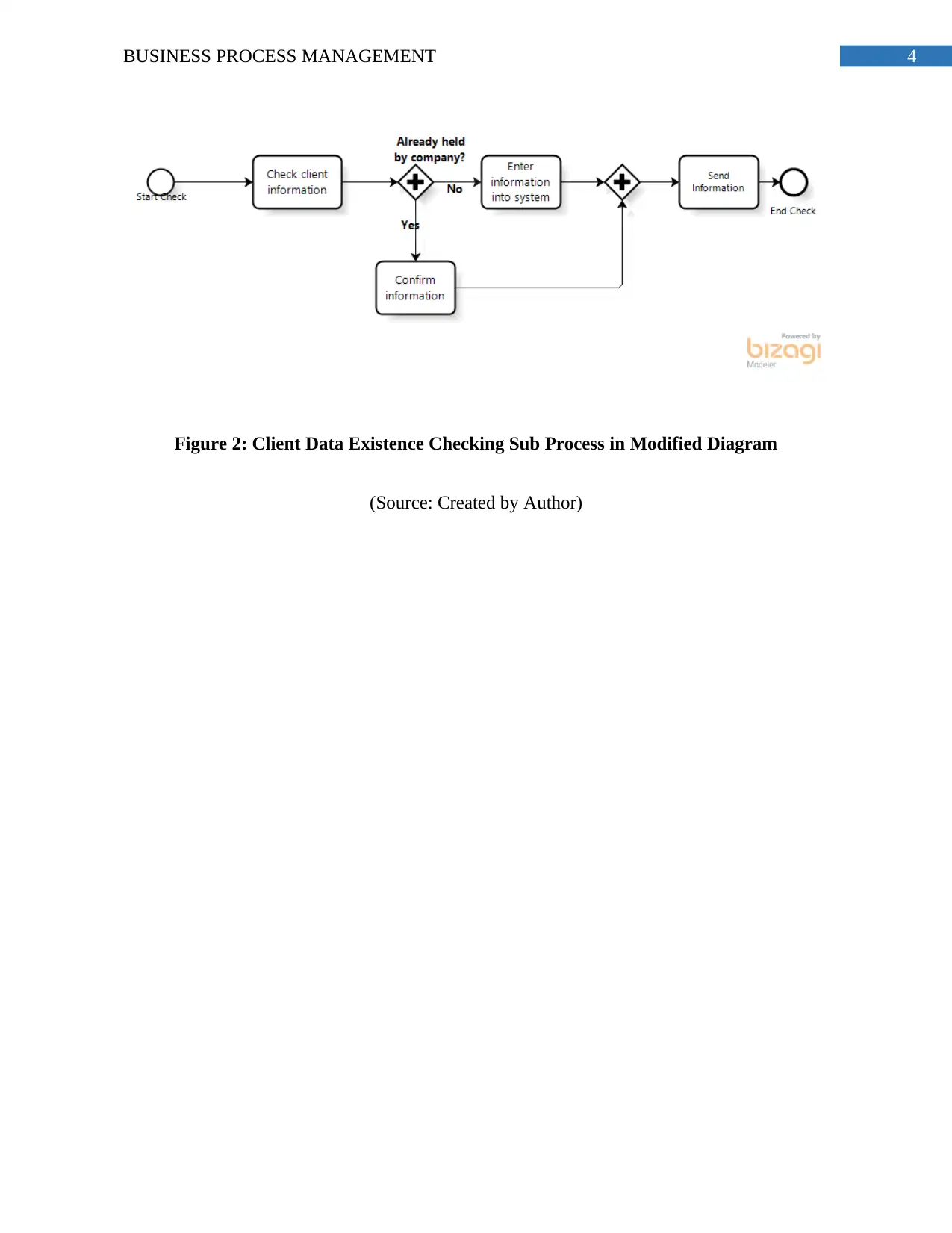
4BUSINESS PROCESS MANAGEMENT
Figure 2: Client Data Existence Checking Sub Process in Modified Diagram
(Source: Created by Author)
Figure 2: Client Data Existence Checking Sub Process in Modified Diagram
(Source: Created by Author)
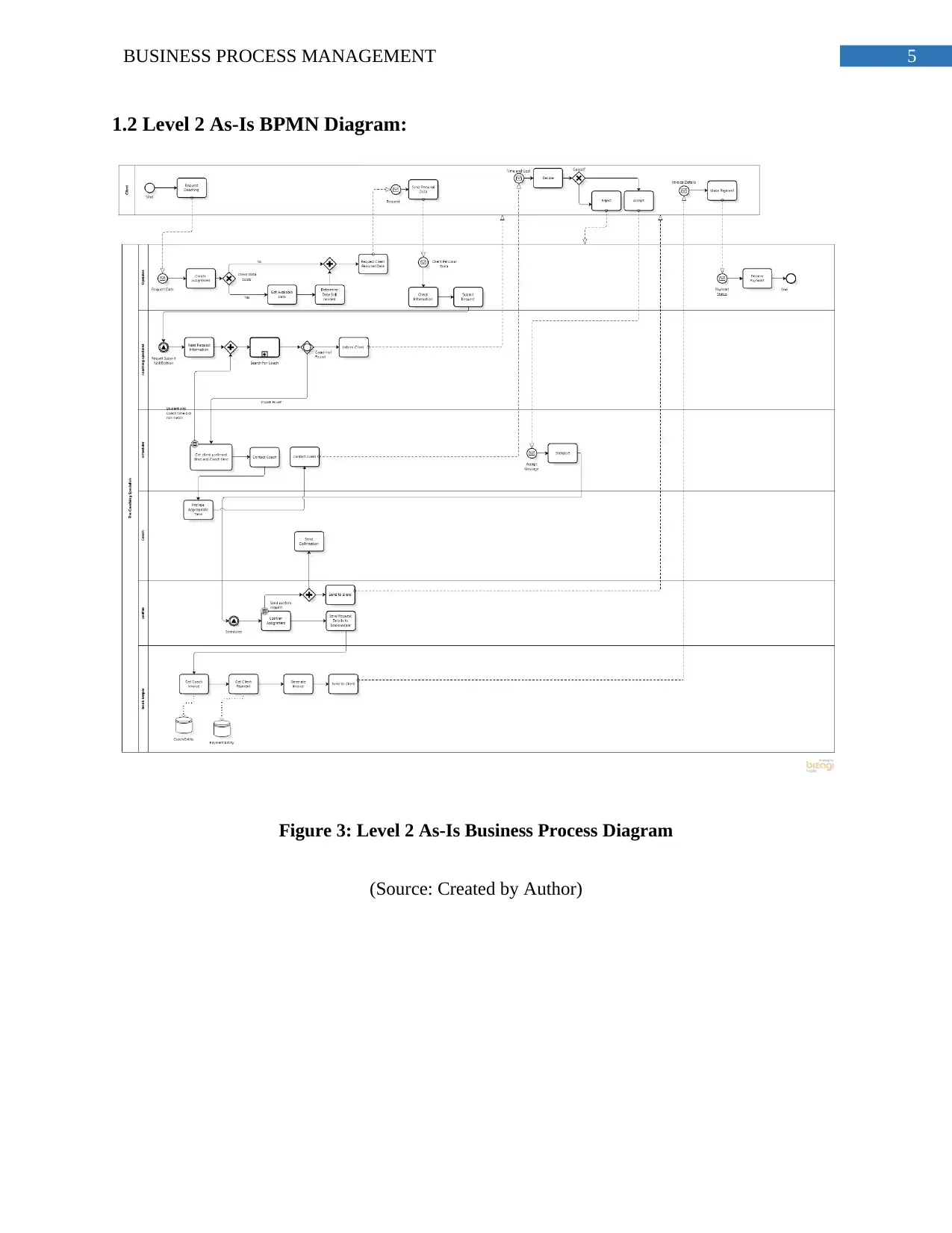
5BUSINESS PROCESS MANAGEMENT
1.2 Level 2 As-Is BPMN Diagram:
Figure 3: Level 2 As-Is Business Process Diagram
(Source: Created by Author)
1.2 Level 2 As-Is BPMN Diagram:
Figure 3: Level 2 As-Is Business Process Diagram
(Source: Created by Author)
⊘ This is a preview!⊘
Do you want full access?
Subscribe today to unlock all pages.

Trusted by 1+ million students worldwide
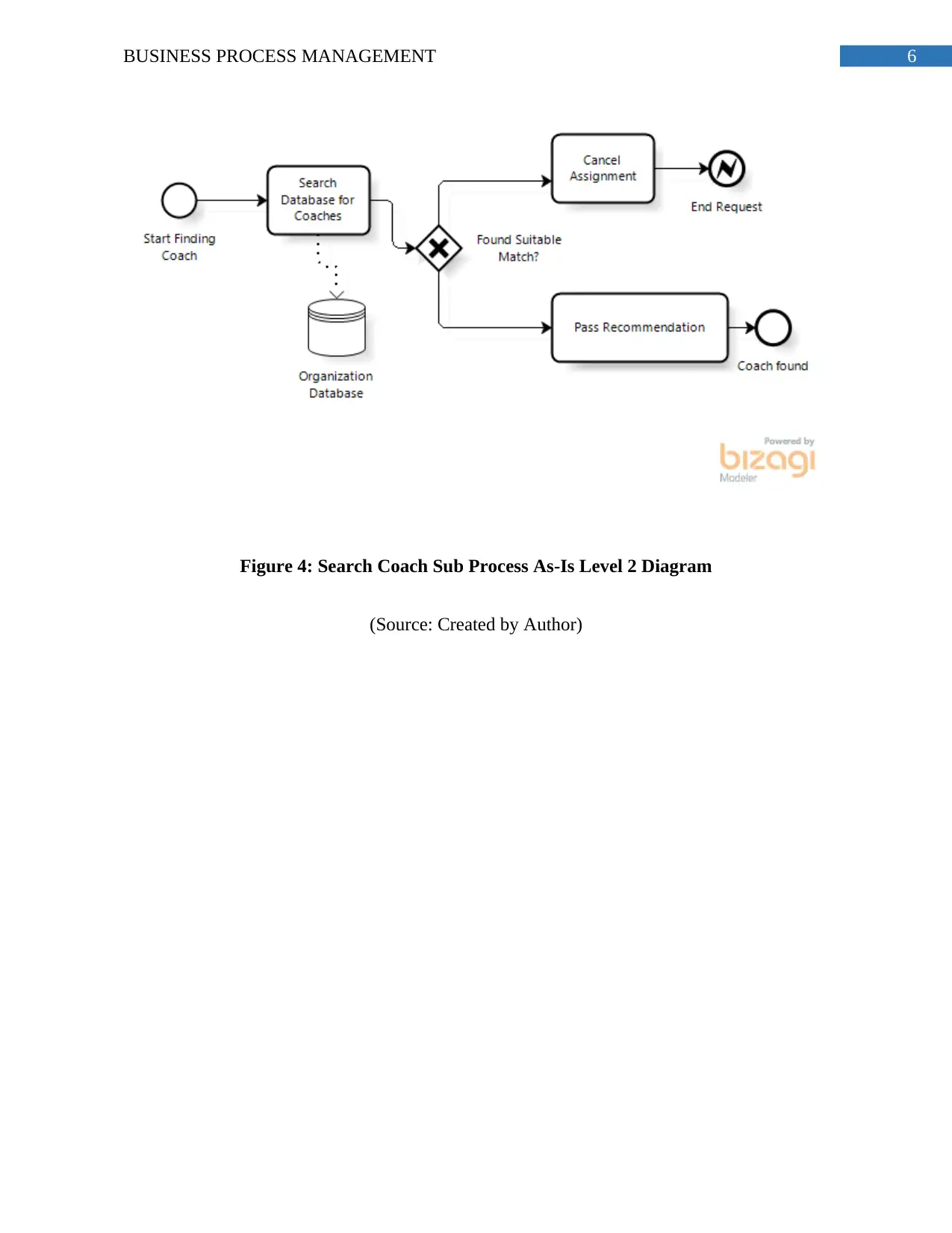
6BUSINESS PROCESS MANAGEMENT
Figure 4: Search Coach Sub Process As-Is Level 2 Diagram
(Source: Created by Author)
Figure 4: Search Coach Sub Process As-Is Level 2 Diagram
(Source: Created by Author)
Paraphrase This Document
Need a fresh take? Get an instant paraphrase of this document with our AI Paraphraser
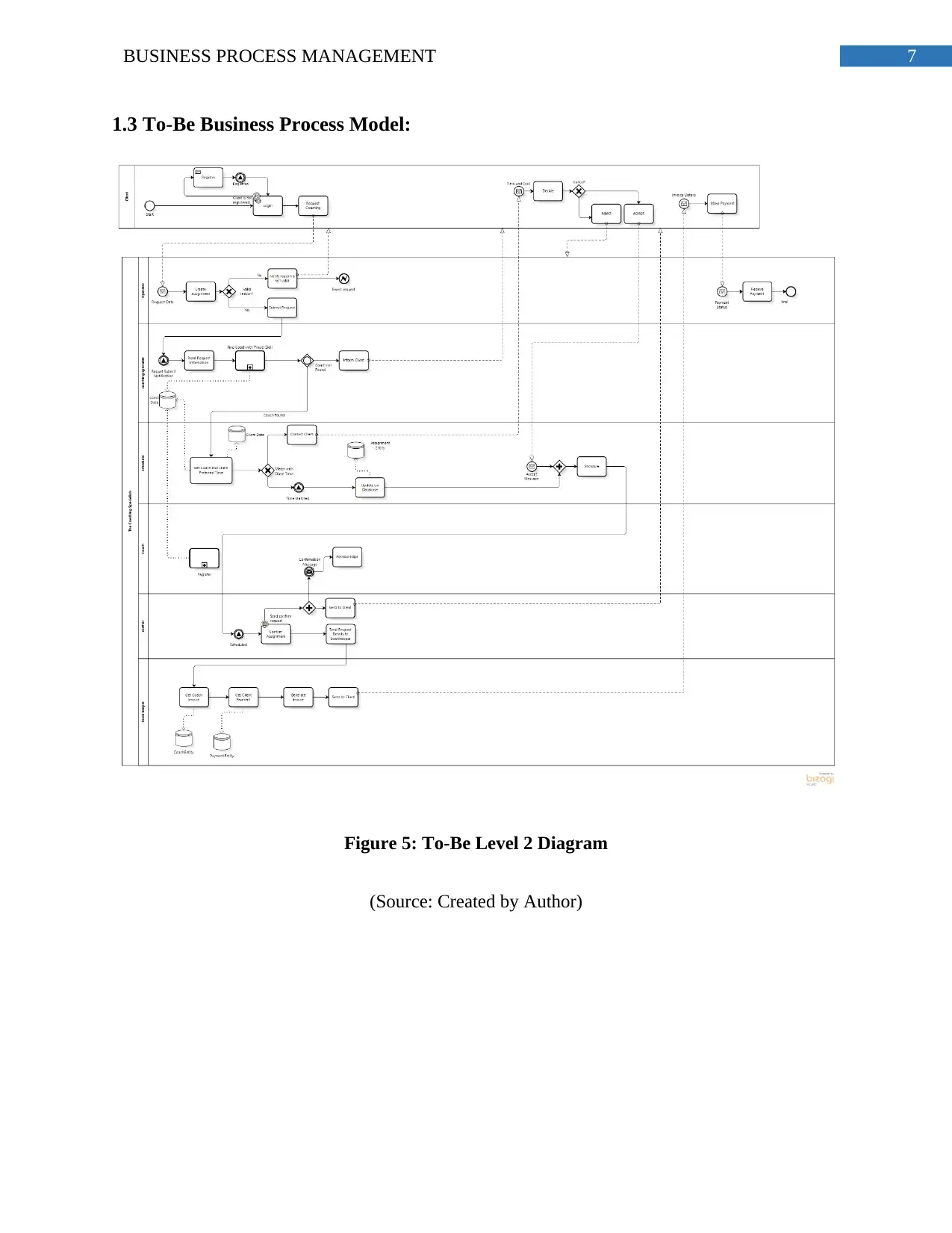
7BUSINESS PROCESS MANAGEMENT
1.3 To-Be Business Process Model:
Figure 5: To-Be Level 2 Diagram
(Source: Created by Author)
1.3 To-Be Business Process Model:
Figure 5: To-Be Level 2 Diagram
(Source: Created by Author)
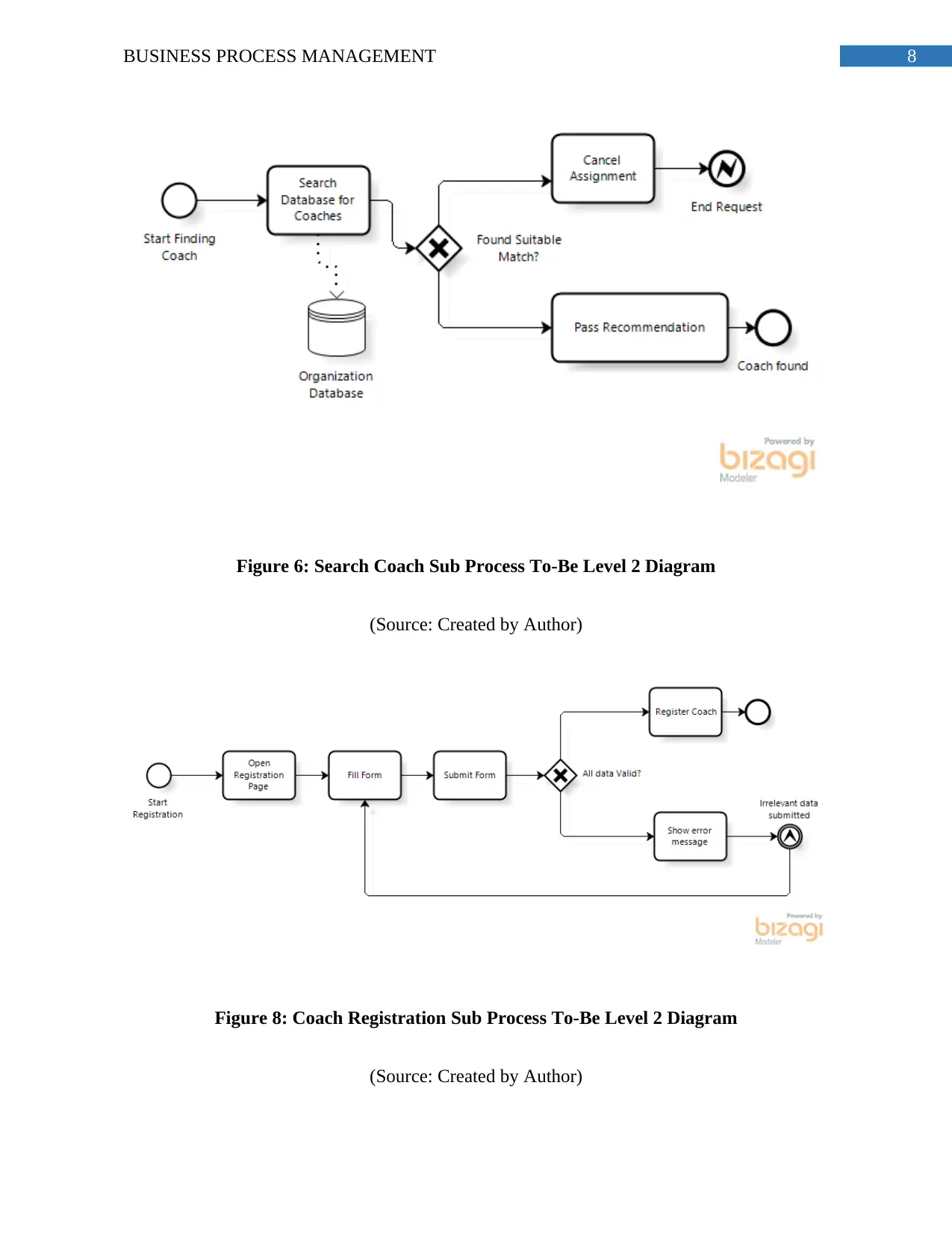
8BUSINESS PROCESS MANAGEMENT
Figure 6: Search Coach Sub Process To-Be Level 2 Diagram
(Source: Created by Author)
Figure 8: Coach Registration Sub Process To-Be Level 2 Diagram
(Source: Created by Author)
Figure 6: Search Coach Sub Process To-Be Level 2 Diagram
(Source: Created by Author)
Figure 8: Coach Registration Sub Process To-Be Level 2 Diagram
(Source: Created by Author)
⊘ This is a preview!⊘
Do you want full access?
Subscribe today to unlock all pages.

Trusted by 1+ million students worldwide
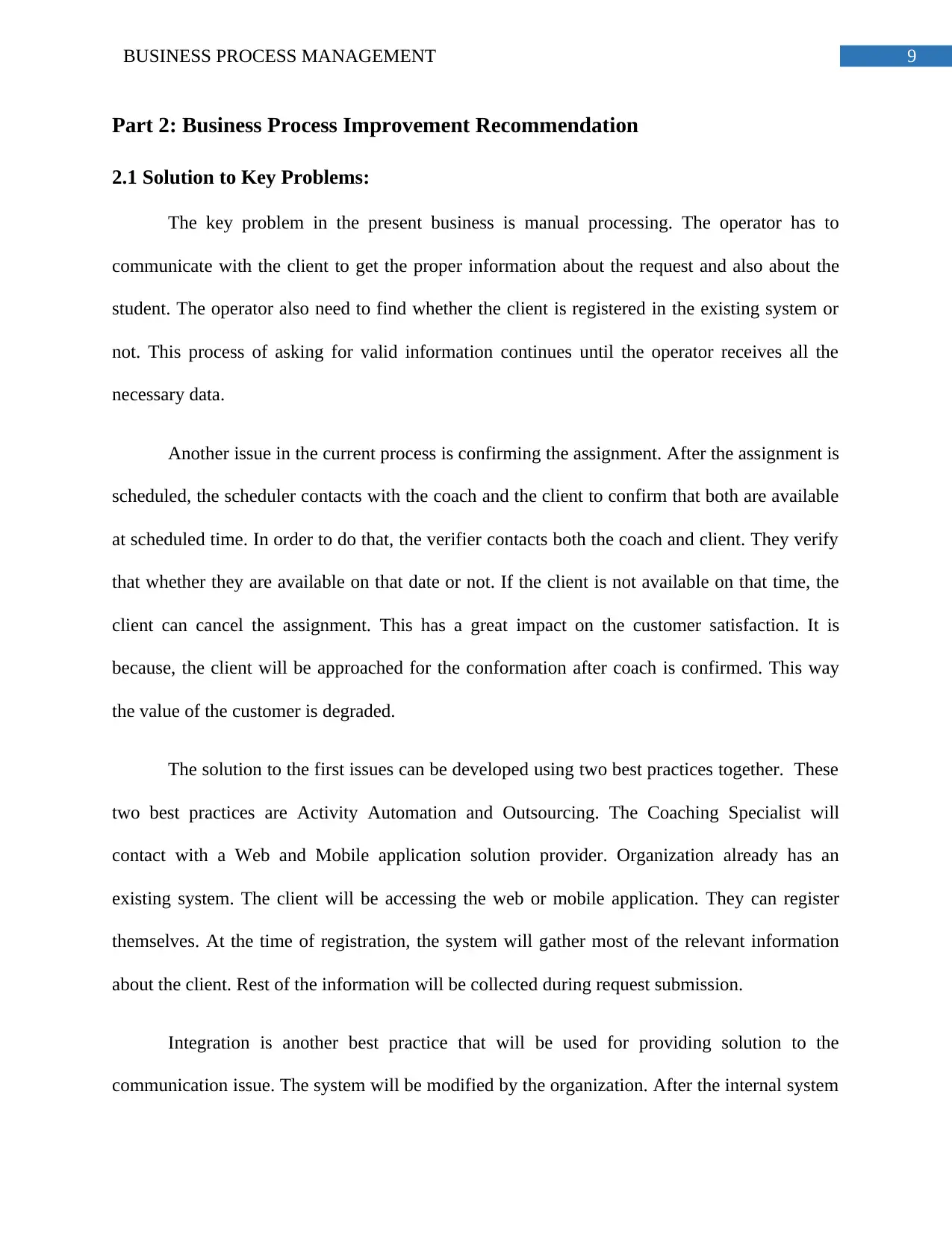
9BUSINESS PROCESS MANAGEMENT
Part 2: Business Process Improvement Recommendation
2.1 Solution to Key Problems:
The key problem in the present business is manual processing. The operator has to
communicate with the client to get the proper information about the request and also about the
student. The operator also need to find whether the client is registered in the existing system or
not. This process of asking for valid information continues until the operator receives all the
necessary data.
Another issue in the current process is confirming the assignment. After the assignment is
scheduled, the scheduler contacts with the coach and the client to confirm that both are available
at scheduled time. In order to do that, the verifier contacts both the coach and client. They verify
that whether they are available on that date or not. If the client is not available on that time, the
client can cancel the assignment. This has a great impact on the customer satisfaction. It is
because, the client will be approached for the conformation after coach is confirmed. This way
the value of the customer is degraded.
The solution to the first issues can be developed using two best practices together. These
two best practices are Activity Automation and Outsourcing. The Coaching Specialist will
contact with a Web and Mobile application solution provider. Organization already has an
existing system. The client will be accessing the web or mobile application. They can register
themselves. At the time of registration, the system will gather most of the relevant information
about the client. Rest of the information will be collected during request submission.
Integration is another best practice that will be used for providing solution to the
communication issue. The system will be modified by the organization. After the internal system
Part 2: Business Process Improvement Recommendation
2.1 Solution to Key Problems:
The key problem in the present business is manual processing. The operator has to
communicate with the client to get the proper information about the request and also about the
student. The operator also need to find whether the client is registered in the existing system or
not. This process of asking for valid information continues until the operator receives all the
necessary data.
Another issue in the current process is confirming the assignment. After the assignment is
scheduled, the scheduler contacts with the coach and the client to confirm that both are available
at scheduled time. In order to do that, the verifier contacts both the coach and client. They verify
that whether they are available on that date or not. If the client is not available on that time, the
client can cancel the assignment. This has a great impact on the customer satisfaction. It is
because, the client will be approached for the conformation after coach is confirmed. This way
the value of the customer is degraded.
The solution to the first issues can be developed using two best practices together. These
two best practices are Activity Automation and Outsourcing. The Coaching Specialist will
contact with a Web and Mobile application solution provider. Organization already has an
existing system. The client will be accessing the web or mobile application. They can register
themselves. At the time of registration, the system will gather most of the relevant information
about the client. Rest of the information will be collected during request submission.
Integration is another best practice that will be used for providing solution to the
communication issue. The system will be modified by the organization. After the internal system
Paraphrase This Document
Need a fresh take? Get an instant paraphrase of this document with our AI Paraphraser
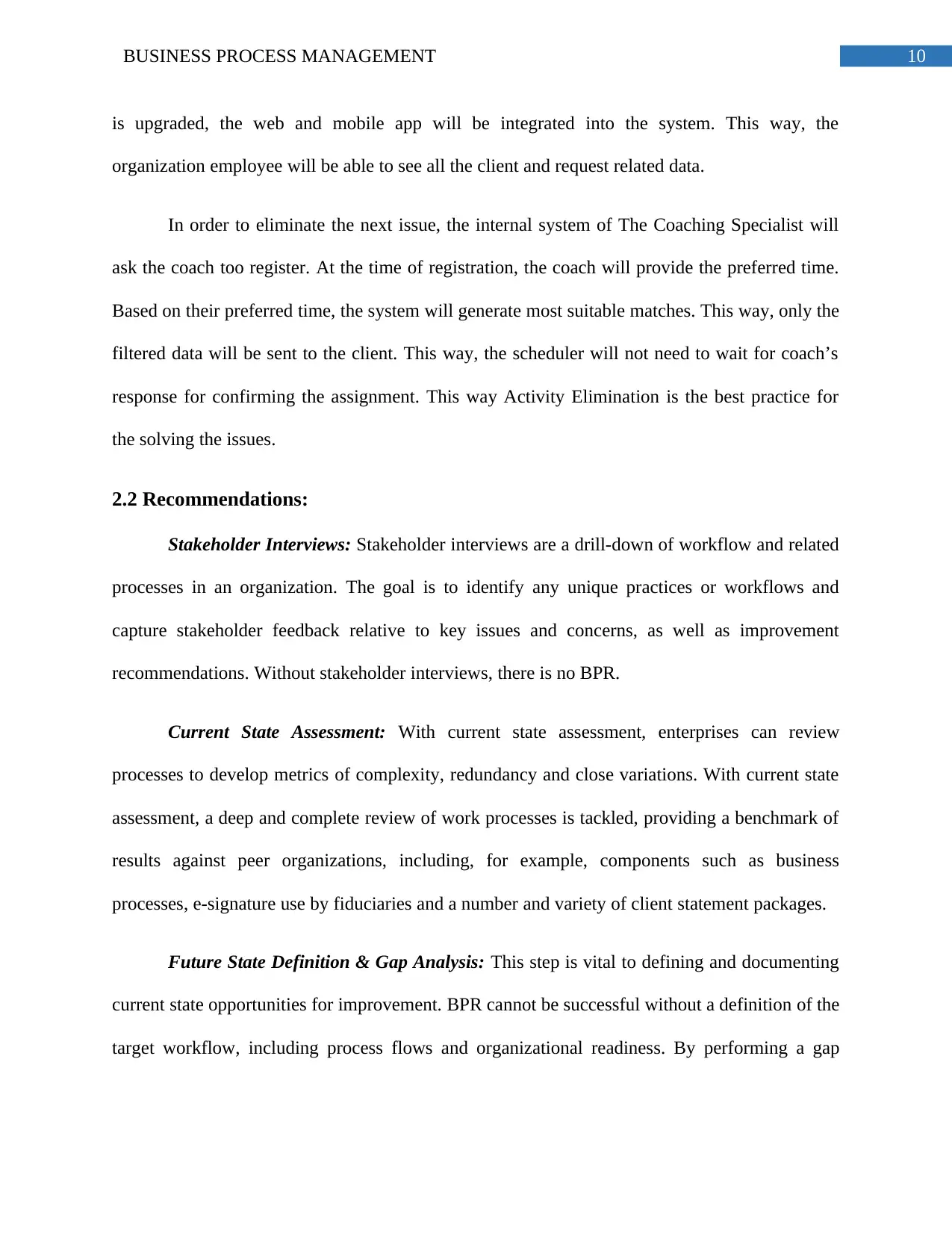
10BUSINESS PROCESS MANAGEMENT
is upgraded, the web and mobile app will be integrated into the system. This way, the
organization employee will be able to see all the client and request related data.
In order to eliminate the next issue, the internal system of The Coaching Specialist will
ask the coach too register. At the time of registration, the coach will provide the preferred time.
Based on their preferred time, the system will generate most suitable matches. This way, only the
filtered data will be sent to the client. This way, the scheduler will not need to wait for coach’s
response for confirming the assignment. This way Activity Elimination is the best practice for
the solving the issues.
2.2 Recommendations:
Stakeholder Interviews: Stakeholder interviews are a drill-down of workflow and related
processes in an organization. The goal is to identify any unique practices or workflows and
capture stakeholder feedback relative to key issues and concerns, as well as improvement
recommendations. Without stakeholder interviews, there is no BPR.
Current State Assessment: With current state assessment, enterprises can review
processes to develop metrics of complexity, redundancy and close variations. With current state
assessment, a deep and complete review of work processes is tackled, providing a benchmark of
results against peer organizations, including, for example, components such as business
processes, e-signature use by fiduciaries and a number and variety of client statement packages.
Future State Definition & Gap Analysis: This step is vital to defining and documenting
current state opportunities for improvement. BPR cannot be successful without a definition of the
target workflow, including process flows and organizational readiness. By performing a gap
is upgraded, the web and mobile app will be integrated into the system. This way, the
organization employee will be able to see all the client and request related data.
In order to eliminate the next issue, the internal system of The Coaching Specialist will
ask the coach too register. At the time of registration, the coach will provide the preferred time.
Based on their preferred time, the system will generate most suitable matches. This way, only the
filtered data will be sent to the client. This way, the scheduler will not need to wait for coach’s
response for confirming the assignment. This way Activity Elimination is the best practice for
the solving the issues.
2.2 Recommendations:
Stakeholder Interviews: Stakeholder interviews are a drill-down of workflow and related
processes in an organization. The goal is to identify any unique practices or workflows and
capture stakeholder feedback relative to key issues and concerns, as well as improvement
recommendations. Without stakeholder interviews, there is no BPR.
Current State Assessment: With current state assessment, enterprises can review
processes to develop metrics of complexity, redundancy and close variations. With current state
assessment, a deep and complete review of work processes is tackled, providing a benchmark of
results against peer organizations, including, for example, components such as business
processes, e-signature use by fiduciaries and a number and variety of client statement packages.
Future State Definition & Gap Analysis: This step is vital to defining and documenting
current state opportunities for improvement. BPR cannot be successful without a definition of the
target workflow, including process flows and organizational readiness. By performing a gap
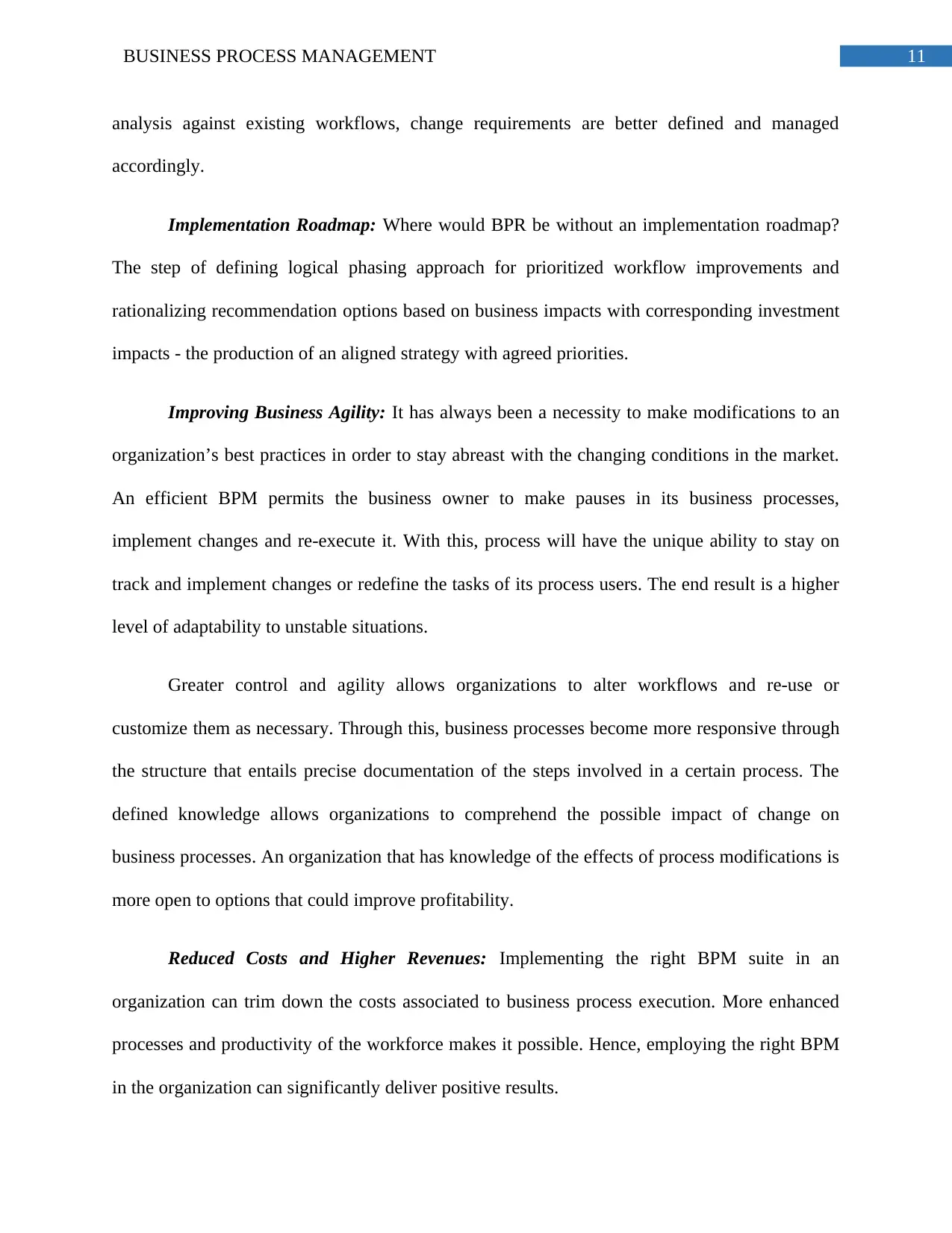
11BUSINESS PROCESS MANAGEMENT
analysis against existing workflows, change requirements are better defined and managed
accordingly.
Implementation Roadmap: Where would BPR be without an implementation roadmap?
The step of defining logical phasing approach for prioritized workflow improvements and
rationalizing recommendation options based on business impacts with corresponding investment
impacts - the production of an aligned strategy with agreed priorities.
Improving Business Agility: It has always been a necessity to make modifications to an
organization’s best practices in order to stay abreast with the changing conditions in the market.
An efficient BPM permits the business owner to make pauses in its business processes,
implement changes and re-execute it. With this, process will have the unique ability to stay on
track and implement changes or redefine the tasks of its process users. The end result is a higher
level of adaptability to unstable situations.
Greater control and agility allows organizations to alter workflows and re-use or
customize them as necessary. Through this, business processes become more responsive through
the structure that entails precise documentation of the steps involved in a certain process. The
defined knowledge allows organizations to comprehend the possible impact of change on
business processes. An organization that has knowledge of the effects of process modifications is
more open to options that could improve profitability.
Reduced Costs and Higher Revenues: Implementing the right BPM suite in an
organization can trim down the costs associated to business process execution. More enhanced
processes and productivity of the workforce makes it possible. Hence, employing the right BPM
in the organization can significantly deliver positive results.
analysis against existing workflows, change requirements are better defined and managed
accordingly.
Implementation Roadmap: Where would BPR be without an implementation roadmap?
The step of defining logical phasing approach for prioritized workflow improvements and
rationalizing recommendation options based on business impacts with corresponding investment
impacts - the production of an aligned strategy with agreed priorities.
Improving Business Agility: It has always been a necessity to make modifications to an
organization’s best practices in order to stay abreast with the changing conditions in the market.
An efficient BPM permits the business owner to make pauses in its business processes,
implement changes and re-execute it. With this, process will have the unique ability to stay on
track and implement changes or redefine the tasks of its process users. The end result is a higher
level of adaptability to unstable situations.
Greater control and agility allows organizations to alter workflows and re-use or
customize them as necessary. Through this, business processes become more responsive through
the structure that entails precise documentation of the steps involved in a certain process. The
defined knowledge allows organizations to comprehend the possible impact of change on
business processes. An organization that has knowledge of the effects of process modifications is
more open to options that could improve profitability.
Reduced Costs and Higher Revenues: Implementing the right BPM suite in an
organization can trim down the costs associated to business process execution. More enhanced
processes and productivity of the workforce makes it possible. Hence, employing the right BPM
in the organization can significantly deliver positive results.
⊘ This is a preview!⊘
Do you want full access?
Subscribe today to unlock all pages.

Trusted by 1+ million students worldwide
1 out of 21
Related Documents
Your All-in-One AI-Powered Toolkit for Academic Success.
+13062052269
info@desklib.com
Available 24*7 on WhatsApp / Email
![[object Object]](/_next/static/media/star-bottom.7253800d.svg)
Unlock your academic potential
Copyright © 2020–2025 A2Z Services. All Rights Reserved. Developed and managed by ZUCOL.



